How YEN prize winners have achieved impressive OSR yields
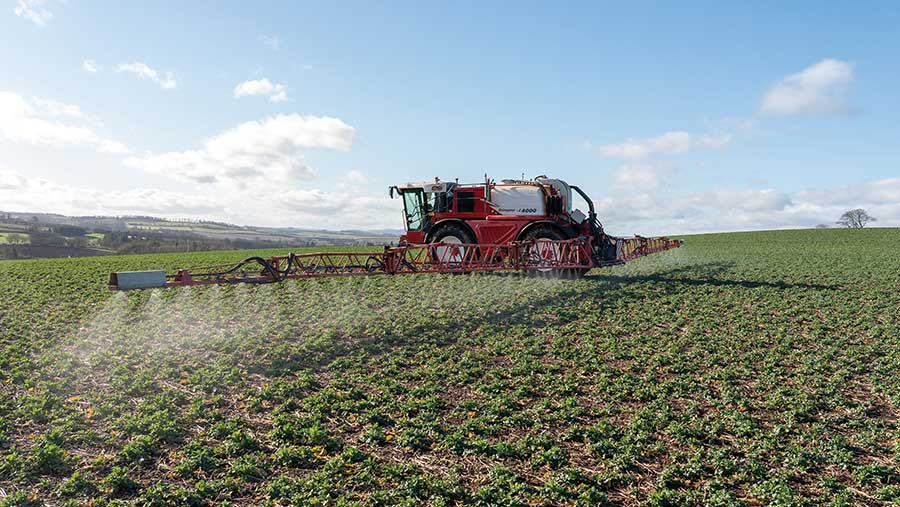 © Angus Findlay
© Angus Findlay UK oilseed rape yields averaged 3t/ha in harvest 2023, but the prize-winning OSR growers at this year’s Yield Enhancement Network Awards achieved more than double this yield from standard farm practice.
See also: Video: Lincs wheat grower claims top prize in 2023 YEN Awards
Gold: Annabel Hamilton, Bee Edge Farm, Berwickshire
Annabel Hamilton won gold with her oilseed rape crop, which yielded an impressive 6.9t/ha at this year’s Yield Enhancement Network (YEN) awards.
Annabel puts her success down to optimising the basics such as pH, drainage and variety choice, before cashing in on marginal gains through tailored micronutrition sprays.
“It’s all about growing the right variety, in the right field, at the right place in the rotation.
“Both my father and I have a competitive nature to perform to our best and keep the business moving forward,” says Annabel.
Micronutrition is now an integral part of crop production, using leaf and grain analysis to address deficiencies.
“This is where marginal gains in promoting extra yield are made, but only once you have the basics correct,” she adds.
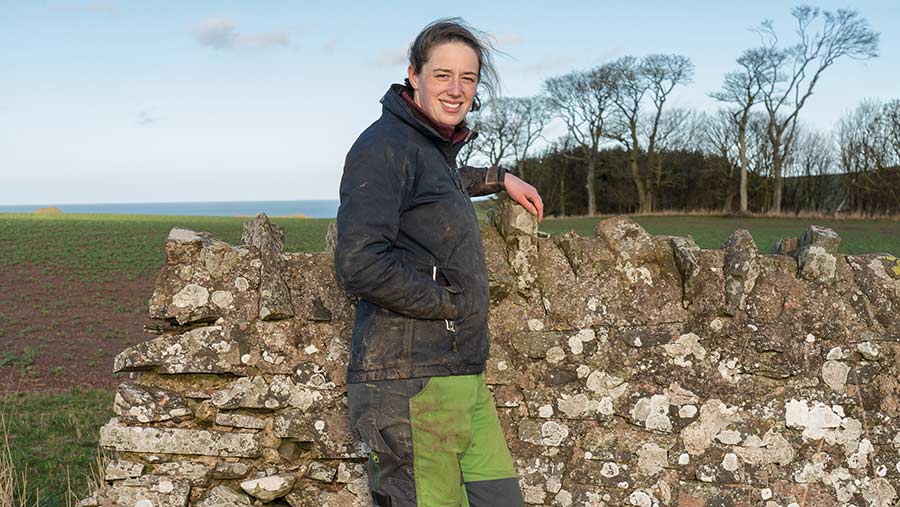
Annabel Hamilton © Angus Findlay
Crop establishment
Farming on the Scottish Borders on the south-east coast of Scotland, Annabel and her father, Will, aim to start drilling OSR in mid-August and finish by the first week of September.
Drilling into moisture is key, with a seed-bed fertiliser comprising 30kg N/ha, phosphate and boron applied to kick-start crops into action.
The winning crop from the hybrid variety INV 1035 was placed in pole position for the best percentage yield potential, achieving 77% of 9.01t/ha for the oilseed category, with an impressive oil content of 45%.
The crop achieved 24 plants/sq m as its final plant count from a seed rate of 40 seeds/sq m and total nitrogen rate of 220kg N/ha.
“Our establishment technique has been quite traditional – either plough, power harrow, then drill; or min-till, power harrow, then drill – but we’re planning to move to a one-pass system to reduce costs,” she says.
A total of 190kg N/ha and 65kg SO3/ha was applied in the spring, split into two applications. The first solid and the second liquid.
Nitrogen applications are monitored closely using green area index information and normalised difference vegetation index (NDVI) imagery.
Muriate of potash was also applied.
Integrating manure from the farm’s fattening cattle operation and various muck-for-straw deals also plays an important role in promoting soil organic matter.

© Angus Findlay
Variety choice
When it comes to variety choice, Annabel opts for hybrids with a minimum resistance score of 7-8 for both phoma and light leaf spot to combat high disease pressure on the Berwickshire coast.
“Fungicide programmes start in the autumn, as we believe prevention is better than cure.
“This allows a reduction in pressure on our spring fungicide, which we time slightly later at green bud stage to allow early sclerotinia protection,” she says.
Disease pressure is monitored closely using a spot-check leaf diagnostic test to get an idea of autumn pressure, along with regular field scouting.
Rainfall, humidity and leaf wetness data is gathered to inform timing and product choice of the main flowering spray.
Two treatments of lambda-cyhalothrin applied with herbicides to control cereal volunteers in the autumn are made, targeting both cabbage stem flea beetle and rape winter stem weevil using weather, temperature and historical migration patterns.
A robust pre-emergence application, along with autumn volunteer control, is followed with propyzamide applications on headlands.
“Our aim is to reduce as much competition to the crop as possible, to aid establishment and speed of growth.”
YEN
For Annabel, being part of YEN is not just a competition, but a chance to understand crops, soils and strive for yield improvements.
“It is a positive event in the farming industry and a great opportunity to network and learn.”
Annabel farms 1,100ha of arable across 10 farms, the majority of which are under contract farming agreements.
Silver: Richard Budd, Stevens Farm, Kent
Silver prize was awarded to Kent grower Richard Budd for his oilseed rape, yielding 6.7t/ha.
Despite being just 0.2t/ha behind Annabel’s winning crop, Richard describes his cropping strategy as “polar opposite”.
Firstly, Richard opts for a drilling date more than a month later than Annabel.
He commences drilling from the 18 September onwards and is confident planting up until the very end of the month.
He grows conventional varieties from carefully selected farm-saved seed in order to cut back on seed costs.
“We’re spending pounds on per-hectare seed costs growing conventionals, rather than hundreds of pounds if we were to grow hybrids,” he explains.
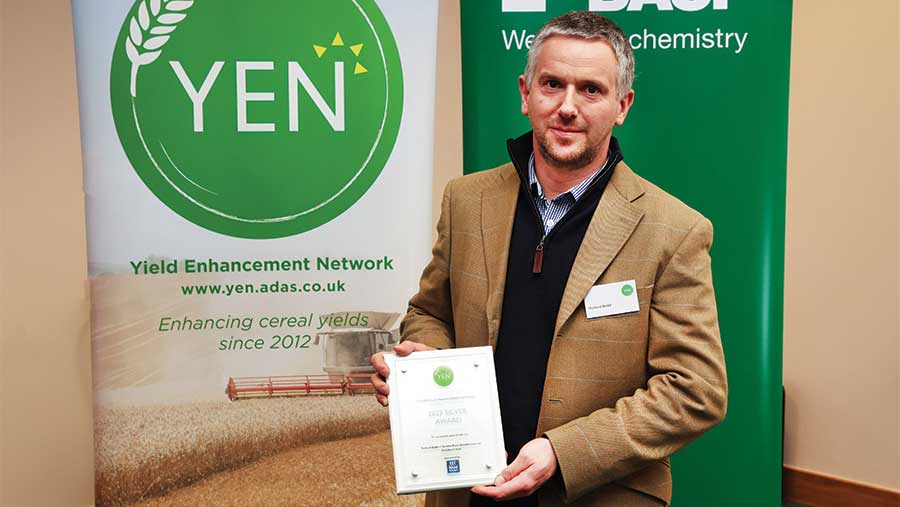
Richard Budd © YEN
High seed rate
Richard grows about 160ha of oilseed rape in a one-in-seven rotation each year.
A high seed rate of 100 seeds/sq m is used, aiming for a thick plant cover of 50-60 plants/sq m going into the winter, to smother out weed pressure.
“Later planting is becoming less of an issue because of the milder winters.
“We’re finding oilseed rape continues to grow new leaves over winter, so we’re looking to reduce seed rates and keep evolving the establishment process,” he says.
Richard previously drilled oilseed rape over the “classic” August bank holiday, like many growers in the area.
However, heavy rainfall at the end of August would often render crops inadequate and require redrilling during mid-September.
It wasn’t until the September re-drills frequently outperformed August established crops that Richard realised he should shift to later drilling.
This also meant crops missed the main flea beetle migration period from late August to early September, which kept fields free from pest attack.
Later planting also brings benefits associated with reduced cereal volunteers, so only two herbicide applications of clethodim and propyzamide are required.
Later drilling also helps minimise frost risks during flowering, which would otherwise knock yield.
Crop establishment
Crops are preloaded with 30kg N/ha, preferably in the form of sewage cake or digestate to kick-start the crops into action.
“If we cannot get hold of this, we will use a starter fertiliser instead. We also roll straight behind the drill to maximise seed-to-soil contact and apply ferric phosphate,” says Richard.
A pass with the low-disturbance subsoiler follows straight after harvest of the previous crop (either second wheat or winter barley).
This allows volunteers to “green up” the crop, which is then sprayed off with glyphosate ahead of direct drilling with the Sumo direct drill.
Richard now uses a disc drill, rather than his previous tine drill, to improve vital seed placement to get crops up and away.
Together with his early dose of N, crops take about seven days to emerge.
“Importantly, all of the crop emerges in a 24- to 48-hour window to reduce any slug grazing effect on the young crop.
“If you have a crop emerging over a long period, then slug grazing has a far greater effect on final plant population,” he says.
A total 200kg/ha of N is applied in either two or three splits from February onwards, weather dependent.
Timely plant growth regulators (PGR) of tebuconazole and metconazole are also key.
“We aim to get on with the PGR as stem extension begins. We need a robust programme to hold the crop’s thick canopy firm and promote a good level of side branching to maximise pod numbers.”
Variety choice
In-house trials investigating conventional variety performance has paid dividends.
With all-time favourite variety Campus starting to show signs of disease breakdown, new varieties Acacia, Amarone and Pinnacle are being scaled up across the farm, following promising trial results.
The silver-winning YEN crop was the variety Acacia, which was planted on the 22 September.
“Pinnacle is looking particularly well this season, with three to four more leaves emerging than the other conventionals and a much greater biomass,” he says.
Richard’s five-year oilseed rape farm average is more than 5t/ha, with his highest ever yield recorded at 7.19t/ha from the variety Campus, back in the harvest of 2019.
Richard farms 1,400ha, with father David, 12 miles south-east of Tunbridge Wells.
Bronze: Lars Riis, Søgaard, Mors, Denmark
Danish farmer Lars Riis took bronze with a yield of 6.5t/ha.
He puts his success down to the integration of pig manure, which makes up 80% of the crop’s nitrogen fertiliser requirements.
“Manure from our pig enterprise plays a valuable role in supporting high yielding and healthy arable crops, which goes a long way to offset purchased nitrogen,” he says.
“If we grow oilseed rape without manure, it is a completely different crop.”
Lars applies the total government limit of 200kg N/ha to his oilseed rape – 160kg N/ha of which is obtained from pig slurry and the remaining 40kg N/ha is from bought-in fertiliser.
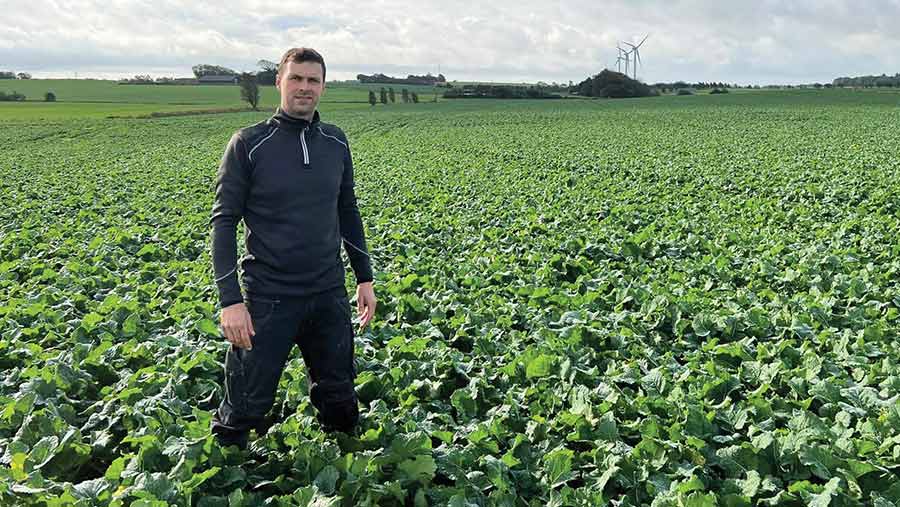
© Supplied by Lars Riis
Importance of pigs
Lars runs a 400ha pig and arable farm in the north-west of the country on the small island of Mors, which lies parallel with south Aberdeenshire, Scotland.
He farms 320 sows and fattens 12,000 pigs each year for the UK market.
The farm averages a whopping 37 piglets a sow, compared with the UK average of 25.
The first application of pig manure goes on ahead of planting OSR in August, where it is incorporated with a cultivator working to a depth of 10cm.
In-crop applications of pig slurry are applied in April with 30kg N/ha of ammonium sulphate applied in early spring.
Drilling commences about the second week of August at a low seed rate of 25 plants/sq m.
This enables crops to establish well in warm conditions, providing plenty of space for a well-branched canopy that can handle cold winter temperatures.
“Over the years, we halved seed rates from 50 to 25 plants/sq m to grow strong plants with lots of side branching and pod numbers.
“We now look for a plant population of 20 plants/sq m with rooting depths of 25-30cm in early October,” he says.
Lars aims to get crops up and away before the weather makes a turn for the worse, which is why he applies a total of 80kg N/ha in the autumn prior to seeding – 50kg N/ha of pig slurry and 30kg N/ha of ammonium nitrate.
He grows the hybrid variety Aviron for its good vigour across all 80ha of OSR. His 10-year average is an impressive 5.7t/ha.
Harvest usually takes place in early August with crops frequently achieving their “birthday”, when they have been grown for one year.
In some cases, next year’s crops can be planted before last year’s are harvested.
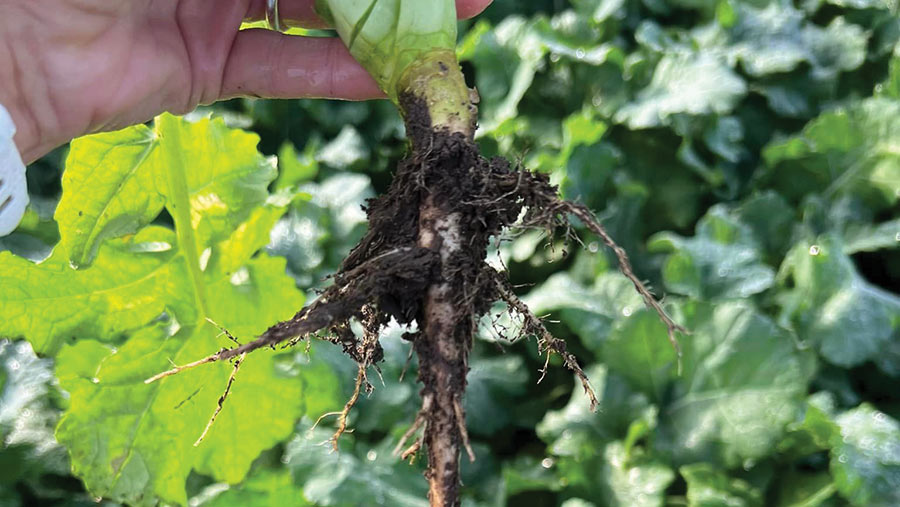
Roots are 25-30cm deep © Lars Riis
Crop protection
Last year, just the one fungicide was applied just before flowering due to dry conditions in May, alongside 10kg of foliar N.
Usually, Lars opts for a follow-up 10 days’ later, but this was not required.
The plough and a robust three-spray herbicide programme effectively controls weeds, ploughing ahead of each crop excluding OSR.
Being part of the YEN programme for four years, micronutrition is now a key focus.
Four micronutrition sprays are applied with a mix of trace elements to promote crop health and boost yield.
“Being part of the network is a great opportunity to meet farmers from across the UK, to better yourself and learn about the small details of crop production.”
“My main focus is improving crop yields,” he concludes.

